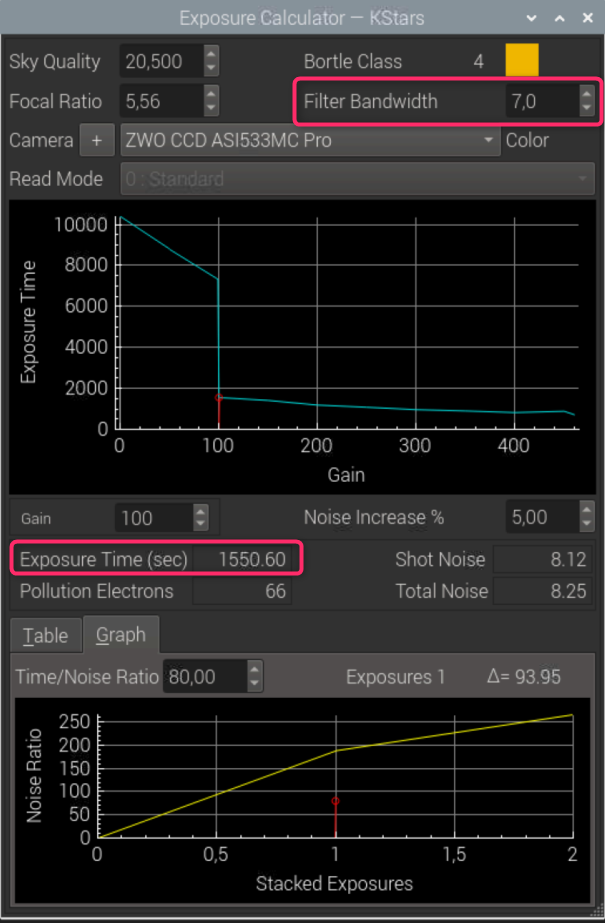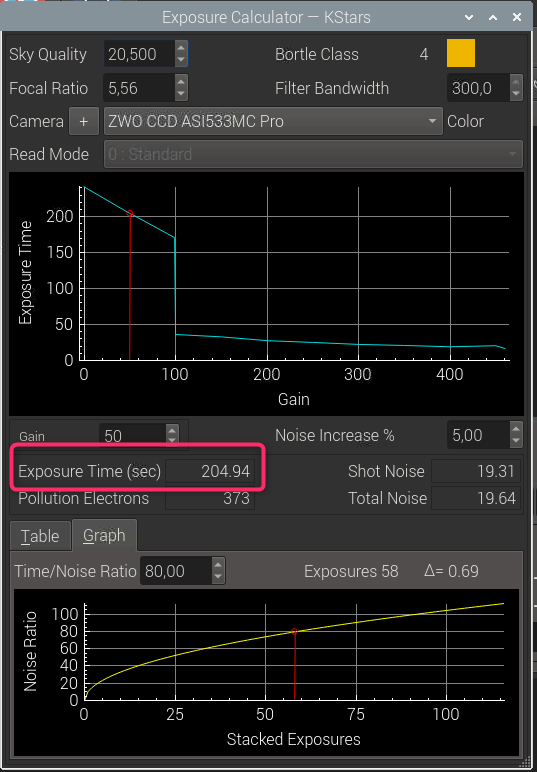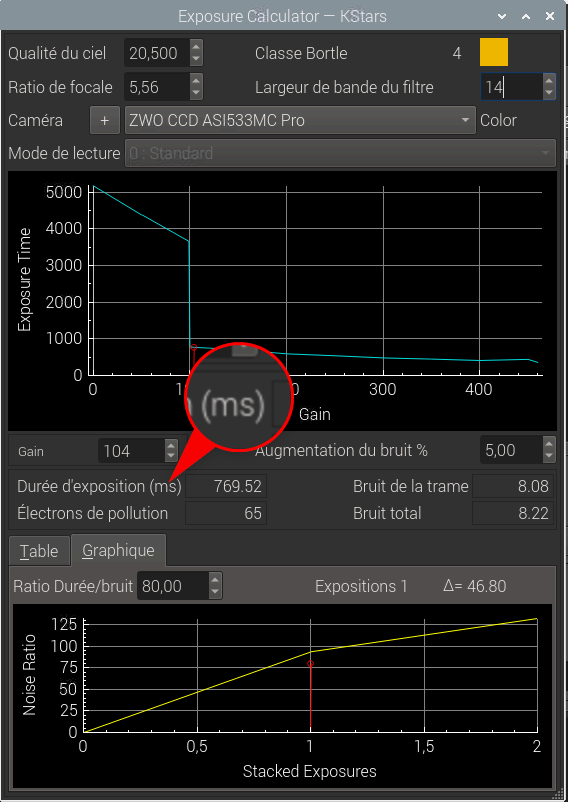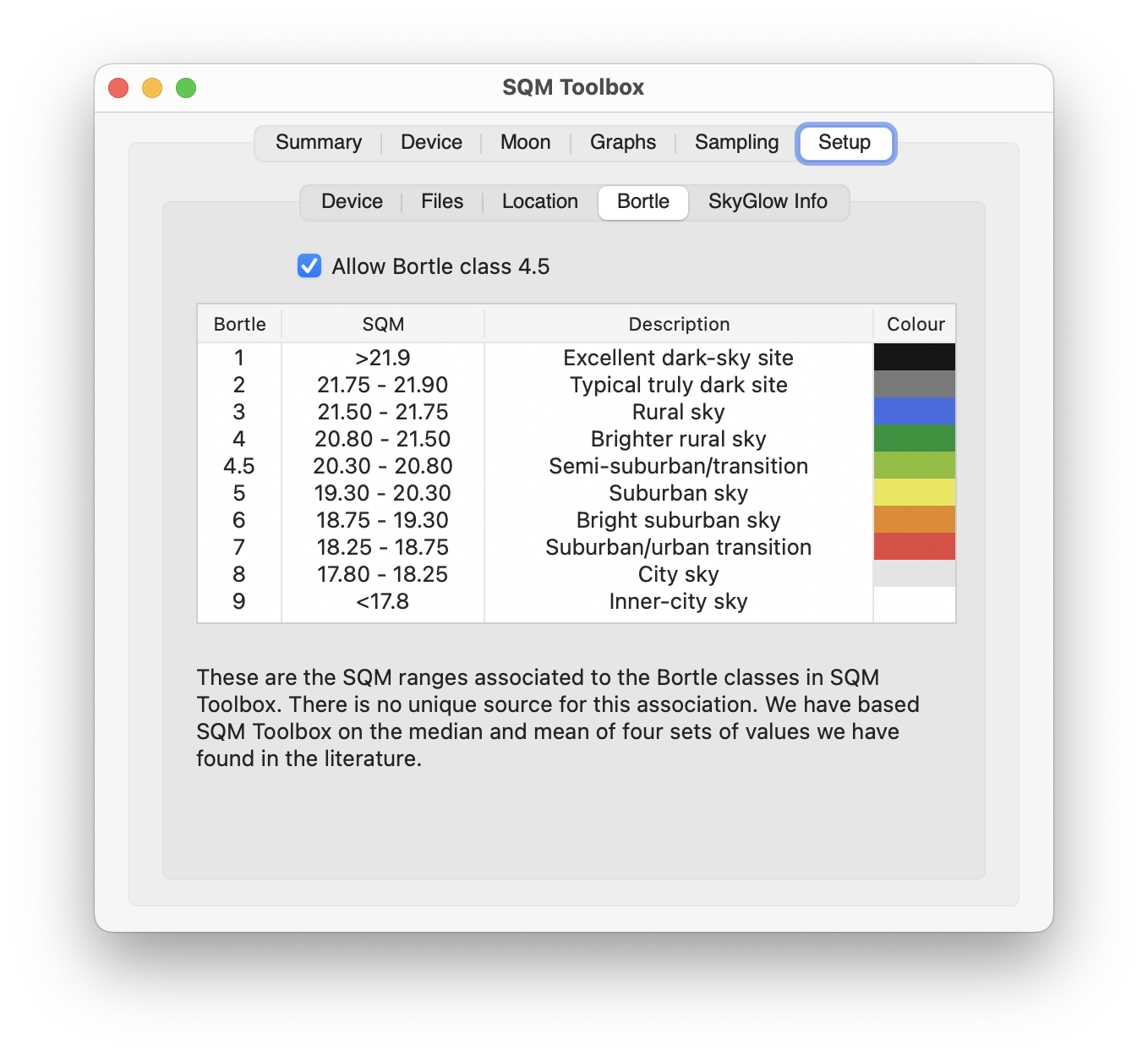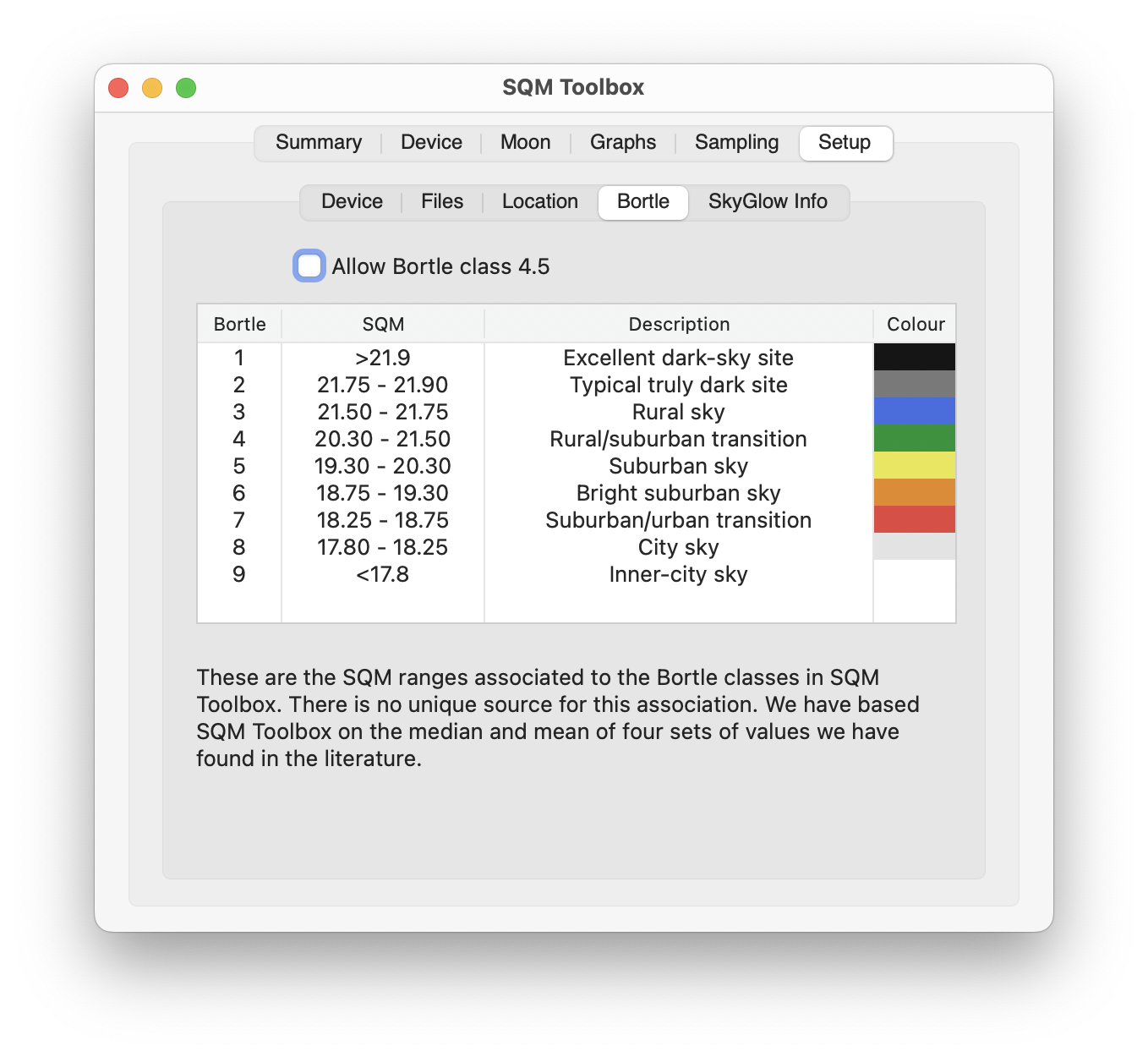INDI Library v2.0.7 is Released (01 Apr 2024)
Bi-monthly release with minor bug fixes and improvements
Optimal Sub-Exposure Calculator help
Replied by vera on topic Optimal Sub-Exposure Calculator help
strange: now we see them in second (I was almost sure to see them seen in ms) ??
quick question , on the screen shot i have used a Filter norrow band - Optolong L-Extreme 7nm.
do i need to use 7 on the Filter Bandwith value as a value ?
is it the case in my example this means that it would take a picture = 1550 sec = 26 mn ?
i'm wrong ?
Please Log in or Create an account to join the conversation.
- Joseph McGee
-

- Offline
- Senior Member
-

- Posts: 42
- Thank you received: 11
Replied by Joseph McGee on topic Optimal Sub-Exposure Calculator help
But even with 14 you may have a longer exposure time than you would prefer to use, due to limitations in guiding etc.
Please Log in or Create an account to join the conversation.
- Joseph McGee
-

- Offline
- Senior Member
-

- Posts: 42
- Thank you received: 11
Replied by Joseph McGee on topic Optimal Sub-Exposure Calculator help
I was travelling when I replied earlier, (using my phone and did not have access to a computer with KStars). So I thought I should give a bit more information to you now that I'm back from my trip.
I would recommend that you move the gain a little bit higher, maybe to 104. This is because the data we use for camera read noise is from graphs in ZWO documentation. But a specific camera might not have that "step" in the read noise exactly at gain 100. So to be certain that you are beyond that step and are really getting the lower read noise, then you need to give a little margin for variations in camera manufacturing.
So with the filter set to 14 nm, the exposure is still fairly long (about 770 seconds). That would be the exposure time from applying the standard noise increase % that Dr Glover recommended. That nearly 13 minute exposure should give an excellent result, because it has great amount of time, and not much noise (time / noise ratio is about 94). But if you would prefer to run a lower exposure time, (worries about guiding, or air traffic, satellites, etc), then you can raise the noise increase %. For example with gain at 104, and Noise increase % at 12.4, the calculation should show an exposure time of about 300 seconds. In your circumstances this should still produce a very good exposure (time / noise ratio is about 57).
Then you can try adjusting the Time/Noise ratio in the stacking calculation to see how many exposures are needed in stacking. Let's assume you are willing to spend about 3 hours imaging. If you are using 770 second exposures, you can reach a Time/Noise ratio of 352 with 14 exposures (just under 3 hours of total integration time). But to reach that same 352 time/noise ratio with the 300 second sub-exposures you would need 38 exposures (about 3 hours 10 minutes of total integration time).
Please Log in or Create an account to join the conversation.
Replied by Vladimir on topic Optimal Sub-Exposure Calculator help
I read that asi294mc has problems with shutter speeds shorter than 1 second. And many owners of this camera recommend taking flat frames with exposure of about 3 seconds and dark flat frames rather than a biases. But this shouldn't happen with asi120mm. Maybe I did something wrong? if it need i'll retake frames.
Please Log in or Create an account to join the conversation.
- Joseph McGee
-

- Offline
- Senior Member
-

- Posts: 42
- Thank you received: 11
Replied by Joseph McGee on topic Optimal Sub-Exposure Calculator help
If you want to retake the Gain 50 frames for the 294, I can re-run that data through my tool. I'd be interested to see if the calculation changes for that gain setting. I'm also curious about the white balance settings that you have on the 294. Are you using auto white balance, or manual? If manual, what values are you using?
As for the exposure time, yes, I had experienced an issue with testing one of my cameras when taking flats with LED panel that had a dimming feature. I found that exposures less than about 1/2 second caused problems for my tool.
Thanks.
Please Log in or Create an account to join the conversation.
Replied by vera on topic Optimal Sub-Exposure Calculator help
after some tests the issue comes from language selected
you're right in English we have Sec but in French i have ms, see my screenshots.
but values are the same.
So is it 769 Sec or 769 ms ???
Maybe is just an translation issue ?
Please Log in or Create an account to join the conversation.
- Joseph McGee
-

- Offline
- Senior Member
-

- Posts: 42
- Thank you received: 11
Replied by Joseph McGee on topic Optimal Sub-Exposure Calculator help
I agree, there appears to be an error in the French translation file. I will try to escalate this for a correction.
Please Log in or Create an account to join the conversation.
- Richard Francis
-

- Offline
- Premium Member
-

- Posts: 146
- Thank you received: 16
Replied by Richard Francis on topic Optimal Sub-Exposure Calculator help
In the dialog there is a conversion from the entered SQM value to Bortle scale. What is the conversion used?
I ask because I have an App in development to read SQM devices and it includes a conversion SQM->Bortle class. But my background research has shown there is no agreed conversion. I found at least 4 different ones (and some introduce a class 4.5 as well). I opted for a combination of median and mean amongst the 4 scales, as far as seemed practical. My table looks like this:
Sorry for the off-topic!
Richard
Attachments:
Please Log in or Create an account to join the conversation.
- Frederick Ruegsegger
-
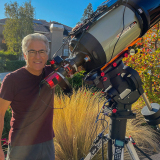
- Offline
- Elite Member
-

- Posts: 211
- Thank you received: 30
Replied by Frederick Ruegsegger on topic Optimal Sub-Exposure Calculator help
Best,
Fred
Please Log in or Create an account to join the conversation.
- Joseph McGee
-

- Offline
- Senior Member
-

- Posts: 42
- Thank you received: 11
Replied by Joseph McGee on topic Optimal Sub-Exposure Calculator help
I struggled with trying to find a "balance" among the few sources I could find for translation of of SQM to Bortle. I guess the main issue is that Bortle scale in inherently subjective. (I'm sort of hoping that SQM being more subjective will supplant the Bortle scale eventually. )
I chose to avoid breaking out the conversion of values using scales that had bortle values with half steps since these were not included included in original document I found by John Bortle. So my approach for the display of the value just employed the following set of conditions similar to your table, (I'd be happy to adjust this if we could find a consensus).
QString skyQualityToBortleClassNumber(double anSQMValue)
{
QString aBortleClassNumber;
if(anSQMValue < 18.38)
{
aBortleClassNumber = "8 to 9";
}
else if(anSQMValue < 18.94)
{
aBortleClassNumber = "7";
}
else if(anSQMValue < 19.50)
{
aBortleClassNumber = "6";
}
else if(anSQMValue < 20.49)
{
aBortleClassNumber = "5";
}
else if(anSQMValue < 21.69)
{
aBortleClassNumber = "4";
}
else if(anSQMValue < 21.89)
{
aBortleClassNumber = "3";
}
else if(anSQMValue < 21.99)
{
aBortleClassNumber = "2";
}
else aBortleClassNumber = "1";
return(aBortleClassNumber);
}
But the function I developed in trying to get a smooth transition while mapping SQM to a bortle class color was a bit more intensive. It took quite a bit of curve fitting is a few ranges:
// calculate a Bortle style color based on SQM
QColor makeASkyQualityColor(double anSQMValue)
{
QColor aSkyBrightnessColor;
int aHueDegree, aSaturation, aValue;
if(anSQMValue < 18.32) // White Zone
{
aHueDegree = 40;
aSaturation = 0; // Saturation must move from
aValue = 254; // Value must move from 254 to 240
}
else if(anSQMValue < 18.44) // From White Zone at 18.32 transitioning to Red Zone at 18.44
{
aHueDegree = 0; // Hue is Red,
// Saturation must transition from 0 to 255 as SQM moves from 18.32 to 18.44
aSaturation = (int)(255 * ((anSQMValue - (double)18.32) / (18.44 - 18.32)));
aValue = 254;
}
else if(anSQMValue < 21.82 )
{
// In the color range transitions hue of Bortle can be approximated with a polynomial
aHueDegree = 17.351411032 * pow(anSQMValue, 4)
- 1384.0773705 * pow(anSQMValue, 3)
+ 41383.66777 * pow(anSQMValue, 2)
- 549664.28976 * anSQMValue
+ 2736244.0733;
if(aHueDegree < 0) aHueDegree = 0;
aSaturation = 255;
aValue = 240;
}
else if(anSQMValue < 21.92) // Transition from Blue to Dark Gray between 21.82 and 21.92
{
aHueDegree = 240;
// Saturation must transition from 255 to 0
aSaturation = (int) ((2550 * (21.92 - anSQMValue)));
// Value must transition from 240 to 100
aValue = (int)(100 + (1400 * (21.92 - anSQMValue)));
}
else if(anSQMValue < 21.99) // Dark gray zone
{
aHueDegree = 240;
aSaturation = 0;
aValue = 100;
}
else // Black zone should only be 21.99 and up
{
aHueDegree = 240;
aSaturation = 0;
aValue = 0;
}
// qCInfo(KSTARS_EKOS_CAPTURE) << "Sky Quality Color Hue: " << aHueDegree;
// qCInfo(KSTARS_EKOS_CAPTURE) << "Sky Quality Color Saturation: " << aSaturation;
// qCInfo(KSTARS_EKOS_CAPTURE) << "Sky Quality Color Value: " << aValue;
aSkyBrightnessColor.setHsv(aHueDegree, aSaturation, aValue);
return(aSkyBrightnessColor);
}
Please Log in or Create an account to join the conversation.
- Joseph McGee
-

- Offline
- Senior Member
-

- Posts: 42
- Thank you received: 11
Replied by Joseph McGee on topic Optimal Sub-Exposure Calculator help
I will take a look at the data as soon as I can, but I'll be travelling for about a week and may not have a chance to run the process until I return home..
Please Log in or Create an account to join the conversation.
- Ronald Scotti
-

- Offline
- Elite Member
-

- Posts: 396
- Thank you received: 17
Replied by Ronald Scotti on topic Optimal Sub-Exposure Calculator help
Might there be a more empirical way to establish a good sub-exposure time. (Many suggest just pick 20-30 seconds and be done with it for the usual situations). But I am thinking along a different approach. In the current Siril release, it uses a connection to "StarNet" to remove stars from an image. Could you take a series of short exposures (1,5,10,20 seconds - so most guided results are reasonable), subtract the stars, calculate the background noise level (subtracting the other sources of noise in the specific camera) and plot a graph of exposure time vs noise (there are probably many ways to do this). Would this information help to ground your calculations with some actual data (could the two approaches be made to agree thru an adjustable parameter) so that you would not have to rely on what you think the SQM value is for the current session?
I know in the past I have used a method of taking broad sky images with digital camera pointing straight up and measuring the background noise from the dark areas in images. I think this was for coming up with sky brightness values to give an estimate of the Bortle value of your site. But I don't remember the specifics, anymore.
Anyway just a suggestion and a question of whether this would be practical and useful?
Please Log in or Create an account to join the conversation.

